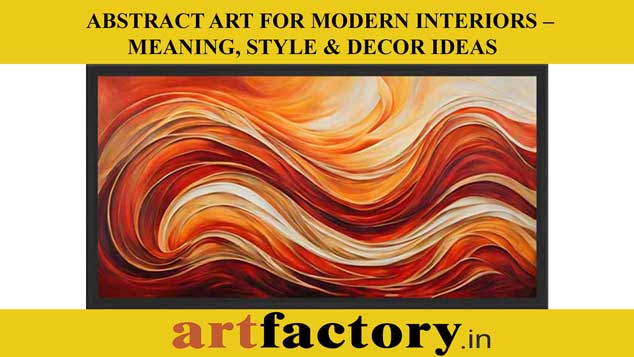
Abstract Art for Modern Interiors: Aesthetic Beauty with Vastu Balance
Abstract Art: More Than Just Visuals
In today's interior design landscape, abstract art has become a symbol of modern expression. Characterized by bold colors, unconventional forms, and fluid movements, it doesn’t depict objects as they are—but how they feel. This freedom makes abstract art timeless, emotional, and versatile. Abstract art is a powerful form of expression that breaks away from depicting visual reality. Instead, it uses shapes, colors, forms, and gestures to evoke emotions and ideas. Unlike representational art, abstract art focuses on the interplay of elements like color, line, and texture to create meaning. Since its emergence in the early 1900s, abstract art has become a cornerstone of modern and contemporary art, reflecting ideals such as order, spirituality, and creativity.
The Birth of Abstract Art: A Journey Through Time
Abstract art didn’t appear in a vacuum. It evolved from earlier art movements like Cubism and Fauvism, which challenged traditional perspectives and bold colors. Pioneers like Wassily Kandinsky and Kazimir Malevich pushed boundaries further, creating works that rejected literal representation.
But there's more to this artistic form than meets the eye. What if your abstract painting could not only beautify your home but also balance the energies of your space?
Welcome to the world of Abstract Vastu Art—where modern design meets ancient energy science.
What is Abstract Art?
Abstract art breaks away from traditional realism. Instead of representing the physical world, it uses shapes, colors, textures, and lines to convey emotion, mood, and energy. This non-representational style gives viewers the freedom to interpret it in their own way.
Abstract works by masters like Kandinsky, Mondrian, and Pollock show us how art can move beyond visual representation to evoke deeper emotions and connections.
Why Abstract Art Works So Well in Modern Spaces
- ✅ Blends with minimalist, contemporary, and even eclectic decor styles
- ✅ Sparks conversation and curiosity
- ✅ Allows personal interpretation and emotional connection
- ✅ Adds vibrancy, depth, and movement to neutral interiors
Whether it’s a large canvas above the sofa or a set of smaller pieces forming a gallery wall, abstract art adapts beautifully to its environment.
Iconic Abstract Artists and Their Masterpieces
Abstract art is defined by its trailblazers. Here are some of the most influential artists and their groundbreaking works:
- Wassily Kandinsky
- Known as the "father of abstract art," Kandinsky believed art should be as expressive as music.
- Composition VII (1913) is a masterpiece of swirling colors and geometric shapes.
- Piet Mondrian
- Championed De Stijl movement, using grids and primary colors to represent harmony.
- Broadway Boogie Woogie (1942–1943) captures the energy of New York City.
- Hilma af Klint
- A Swedish pioneer who created abstract works decades before Kandinsky, exploring spirituality through art.
A New Dimension: Abstract Vastu Art
As interior design evolves, so does the need to harmonize spaces with energy. This is where Abstract Vastu Art comes into play—offering a unique blend of aesthetic appeal and energetic alignment based on the five elements of Vastu Shastra:
- Earth
- Water
- Fire
- Air
- Space
Using colors, forms, and textures associated with these elements, abstract art can now balance your home's energy while looking stunningly modern.
Balancing the 5 Elements of Vastu with Abstract Art
Each direction in Vastu Shastra is associated with one of the five elements. Here’s how abstract Vastu art can help align these energies naturally and stylishly:
1. 🌍 Earth Element (Prithvi) – Stability & Support
- Direction: South-West
- Colors: Beige, Yellow, Brown
- Abstract Style: Geometric shapes, layered earthy textures, grounding patterns
- Effect: Strengthens relationships, family bonding, and emotional grounding
2. 🌊 Water Element (Jal) – Flow & Opportunities
- Direction: North
- Colors: Deep Blue, Black
- Abstract Style: Fluid lines, spiral movements, wave-inspired textures
- Effect: Boosts career success, financial growth, and emotional fluidity
3. 🔥 Fire Element (Agni) – Passion & Fame
- Direction: South-East & South
- Colors: Red, Orange, Pink
- Abstract Style: Bold brushstrokes, sharp angular shapes, rising flame patterns
- Effect: Ignites creativity, enhances recognition, and increases enthusiasm
4. 🌬 Air Element (Vayu) – Growth & Communication
- Direction: East
- Colors: Green, Light Blue
- Abstract Style: Upward spirals, flying forms, abstract kites
- Effect: Improves communication, networking, and fresh ideas
5. 🌌 Space Element (Aakash) – Expansion & Clarity
- Direction: Center & West
- Colors: White, Grey, Violet
- Abstract Style: Minimalist compositions, open space on canvas, large negative spaces
- Effect: Enhances mental peace, spiritual connection, and openness
Abstract Vastu Art: Style with Purpose
What makes Abstract Vastu Art so special is its dual function:
- 🎨 It complements modern decor with its minimalist and artistic appeal
- 🔮 It aligns your space energetically with Vastu principles
This makes it an ideal choice for:
- Homeowners seeking both beauty and balance
- Offices needing creative energy and productivity
- Wellness spaces focusing on calm and clarity
- Artists and designers exploring mindful interiors
Tips to Choose the Right Abstract Art
- Match with Vastu Direction: Select artwork based on the element/direction energy you want to enhance
- Size & Scale: Choose large statement pieces for open walls; smaller artworks for clusters
- Frame & Finish: Float mounts and minimalist frames suit abstract works best
- Intuition First: Always choose what resonates with your energy and taste
Final Thoughts: Where Art Meets Energy
Abstract art has always been a medium of emotional freedom and personal connection. By blending it with Vastu Shastra, we unlock a powerful new category—art that’s not just visually impactful, but also energetically aligned.
So, the next time you're choosing artwork for your living room, workspace, or bedroom, consider Abstract Vastu Art. Let your walls reflect not just your style—but your intentions, energy, and purpose.

Comments : (0)